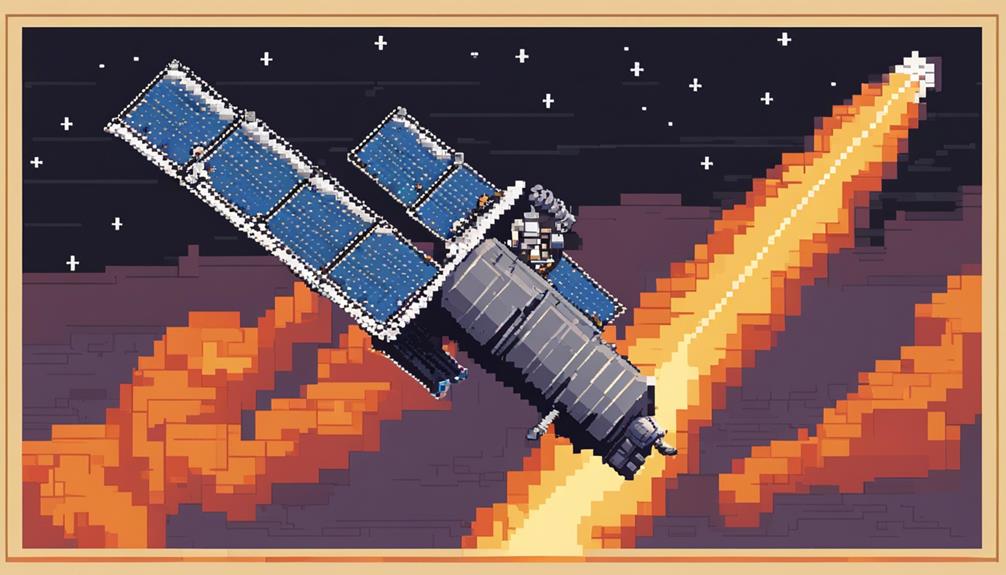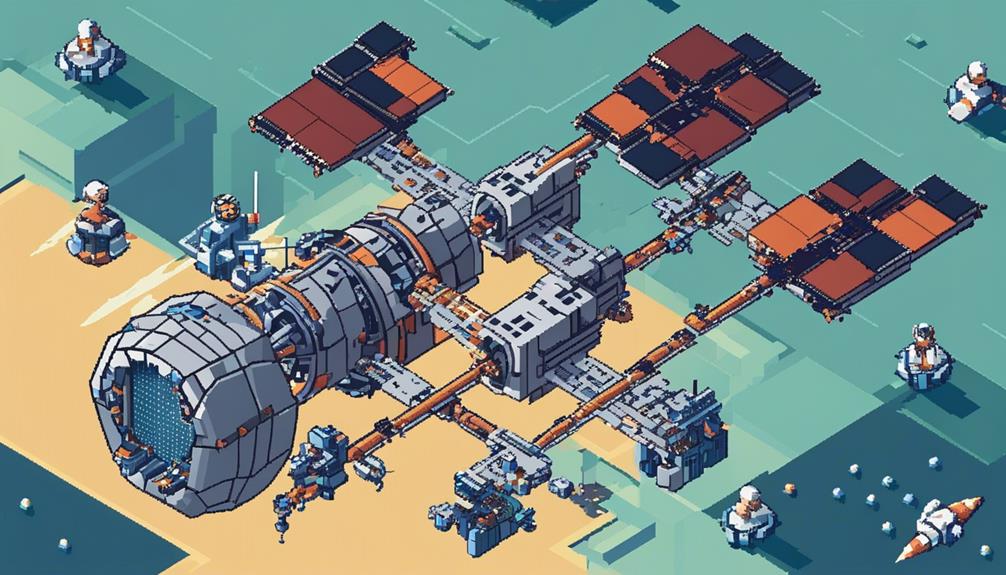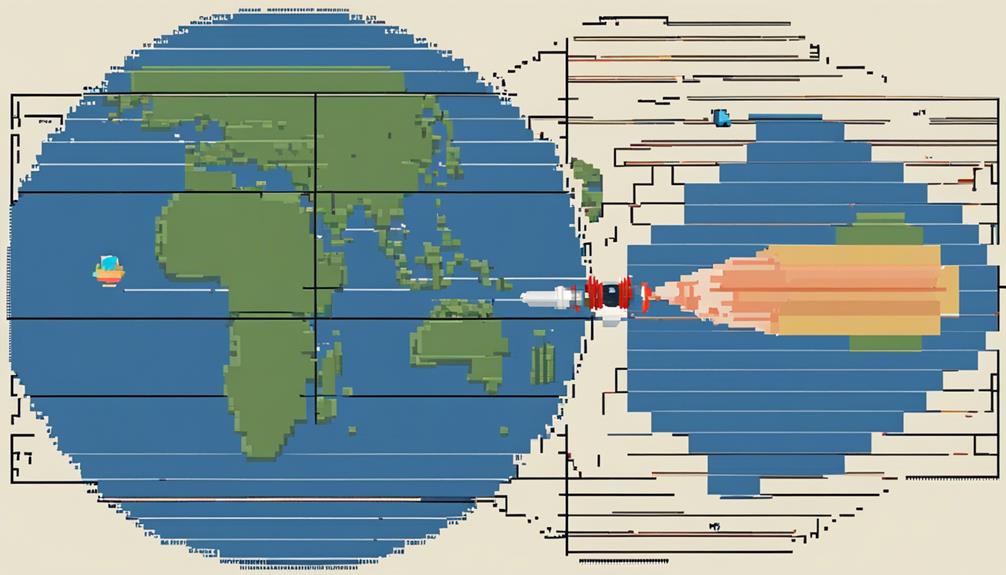In the realm of satellite operations, the management of satellites reaching their end-of-life phase is a multifaceted and crucial endeavor. As we navigate the complexities of satellite disposal, questions arise regarding the most effective strategies for deorbiting or re-entering satellites to prevent catastrophic collisions in space. The considerations of energy dissipation, financial implications, and international regulations further compound the challenge. With the increasing number of satellites in orbit, the discussion on end-of-life management warrants meticulous attention to ensure a sustainable space environment.
Key Takeaways
- Sustainable satellite decommissioning practices ensure a safe orbital environment.
- Compliance with regulatory guidelines is crucial for responsible satellite disposal.
- Innovations in on-orbit servicing drive advancements in end-of-life satellite management.
- International collaboration fosters global cooperation in satellite EOL practices.
Satellite Deorbiting Practices

Implementing efficient satellite deorbiting practices is crucial in mitigating space debris and reducing the risk of collisions in orbit. Deorbiting devices such as drag sails and electrodynamic tethers are essential tools in managing orbital debris by facilitating the safe disposal of defunct satellites at the end of their operational life. These devices work by utilizing various mechanisms to decrease a satellite's velocity and lower its orbit, ultimately leading to re-entry into the Earth's atmosphere.
Drag sails are passive devices that increase the surface area exposed to atmospheric drag, causing a satellite to gradually slow down and descend into the denser layers of the atmosphere. On the other hand, electrodynamic tethers use the Earth's magnetic field to generate electrical currents that interact with the ionosphere, producing drag that helps deorbit the satellite efficiently.
Activation of deorbiting devices at the appropriate time is critical to ensure timely disposal of satellites, preventing them from becoming hazardous space debris. By removing defunct satellites from orbit promptly, the risk of collisions with operational satellites is significantly reduced, contributing to a safer and more sustainable space environment. Proper implementation of deorbiting practices is paramount in addressing the growing concerns surrounding orbital debris accumulation and safeguarding crucial space assets.
Re-Entry Disposal Methods
Re-entry disposal methods are crucial for safely removing defunct satellites from orbit. Controlled deorbit maneuvers and passive deorbit strategies are common approaches employed in this process. These methods aim to reduce collision risks and prevent the generation of additional space debris.
Controlled Deorbit Maneuvers
Controlled deorbit maneuvers, utilizing satellite propulsion systems, are crucial procedures designed to safely guide satellites back into the Earth's atmosphere for disposal. These maneuvers play a vital role in mitigating space debris by ensuring controlled re-entry. Specific calculations for timing and trajectory are paramount to guarantee the safe disposal of the satellite. By gradually reducing altitude and speed using onboard thrusters, satellites can be directed to burn up upon re-entry, minimizing collision risks. This proactive approach to end-of-life management showcases the industry's commitment to responsible satellite operations and space sustainability.
| Key Points of Controlled Deorbit Maneuvers | |||
|---|---|---|---|
| Utilize satellite propulsion systems | Ensure safe disposal | Minimize collision risks | Contribute to space debris mitigation |
Passive Deorbit Strategies
Guiding satellites towards safe re-entry through the utilization of passive deorbit strategies marks a critical phase in end-of-life management processes within the realm of satellite operations and space sustainability. Passive deorbit strategies, such as drag sails and electrodynamic tethers, play a crucial role in lowering satellite orbits for controlled re-entry into the Earth's atmosphere. By leveraging atmospheric drag or electromagnetic forces, these methods facilitate the efficient disposal of satellites at the End-of-Life (EOL) stage, reducing collision risks with operational spacecraft and contributing to space debris mitigation efforts. Implementing passive deorbit strategies is imperative for managing space debris effectively and ensuring a sustainable space environment conducive to ongoing satellite operations and future space exploration endeavors.
Environmental Impact Considerations

Considering the environmental impact of satellite end-of-life management is essential in ensuring sustainable practices in space operations. Eco-friendly disposal methods such as controlled re-entry play a significant role in reducing the potential harm to ecosystems. Sustainable satellite decommissioning practices aim to mitigate the long-term effects on the environment, emphasizing the importance of responsible space activities.
Eco-Friendly Disposal Methods
In the realm of satellite end-of-life management, the consideration of eco-friendly disposal methods is paramount due to their vital role in minimizing environmental impact. Eco-friendly disposal methods for satellites include strategies like lunar impact, Earth reentry, and graveyard orbits. These methods aim to minimize environmental impact by safely disposing of defunct satellites and space debris. Controlled, semi-controlled, and uncontrolled strategies are considered for lunar impact and Earth reentry to manage disposal effectively. Geocentric and heliocentric graveyard orbits provide options for long-term satellite disposal without causing harm to operational spacecraft. Implementing these methods is essential for maintaining a sustainable orbital environment and reducing space debris risks.
Impact on Ecosystems
The disposal of defunct satellites at the end of their operational life can have significant implications on terrestrial and aquatic ecosystems, primarily through the potential release of hazardous materials and contamination from spacecraft re-entries. Satellite components surviving re-entry may scatter over land or bodies of water, disrupting ecosystems. Space debris resulting from failed satellite disposal poses long-term environmental consequences, impacting biodiversity. Effective end-of-life management strategies are crucial to minimize the ecological footprint of satellites and safeguard global ecosystems.
| Impact on Ecosystems | Key Points |
|---|---|
| Hazardous Materials Release | Unburned propellants and batteries |
| Contamination from Re-entries | Potential toxic substances in terrestrial/aquatic ecosystems |
| Ecosystem Disruption | Scattering of satellite components |
| Long-term Consequences | Space debris affecting biodiversity |
| Management Importance | Essential for ecological preservation |
Sustainable Satellite Decommissioning
With a focus on minimizing environmental impact, sustainable satellite decommissioning involves the safe removal of satellites from orbit to mitigate space debris accumulation and prevent collisions with active spacecraft.
- De-orbiting defunct satellites ensures a sustainable space environment.
- On-orbit servicing and de-orbiting devices enhance sustainability in satellite decommissioning.
- International collaboration and regulations promote responsible end-of-life practices for satellites.
- Strategies are aimed at reducing the negative impact of satellite life on the space environment.
Regulatory Compliance Guidelines

Ensuring adherence to regulatory compliance guidelines is paramount in the management of end-of-life satellites to mitigate space debris risks and maintain a secure orbital environment. Regulatory frameworks such as the UN Space Debris Mitigation Guidelines and the Inter-Agency Space Debris Coordination Committee guidelines play a crucial role in ensuring responsible satellite disposal. These guidelines outline proper procedures for satellite re-entry or re-orbit to minimize the generation of space debris and reduce the risk of collisions in space. International collaboration is essential to establish and enforce these regulatory standards, fostering sustainable space activities and preserving the orbital environment for future missions.
To provide a clearer understanding, the table below highlights key aspects of regulatory compliance guidelines for end-of-life satellite management:
| Regulatory Aspect | Description | Importance |
|---|---|---|
| UN Space Debris Mitigation Guidelines | Framework for managing end-of-life satellites and reducing space debris risks | Ensures responsible satellite disposal |
| Inter-Agency Space Debris Coordination Committee Guidelines | Guidelines for proper satellite re-entry or re-orbit procedures | Mitigates space debris risks |
| International Collaboration | Essential for establishing and enforcing regulatory standards for sustainable space activities | Ensures a safe and secure orbital environment |
Adhering to these regulatory compliance guidelines is crucial for preventing space debris accumulation, safeguarding operational satellites, and preserving the long-term sustainability of space exploration endeavors.
Satellite Decommissioning Best Practices
Adherence to satellite decommissioning best practices is essential to mitigate collision risks and maintain a sustainable orbital environment. When it comes to satellite decommissioning, the following best practices are crucial:
- Timely De-Orbiting: Ensuring satellites are de-orbited promptly at the end of their operational life reduces the risk of collisions with active satellites and space debris.
- Deployment of De-Orbiting Devices: Utilizing de-orbiting devices such as drag sails and electrodynamic tethers can facilitate the safe re-entry of satellites into the Earth's atmosphere.
- Risk Reduction: Expedited re-entry of decommissioned satellites significantly decreases the likelihood of collisions with other space objects, thereby contributing to overall space safety.
- Sustainability: Effective satellite decommissioning practices are fundamental for preserving a sustainable space environment by minimizing the accumulation of space debris and potential hazards in orbit.
Space Debris Mitigation Strategies

Space debris mitigation strategies are essential for safeguarding the sustainability of space operations and infrastructure by preventing the generation of debris from space systems. These strategies focus on preventing debris creation, managing existing debris, and planning for the safe disposal of satellites at the End-of-Life (EOL) stage. To achieve this, defined protected zones in low-earth orbit (LEO) and geostationary earth orbit (GEO) regions are crucial in mitigating risks associated with space debris.
Guidelines have been established by various organizations for the management of satellites in Lagrangian Points Orbit (LPO) and Highly Elliptical Orbit (HEO) missions to minimize the generation of space debris. Feasible disposal strategies such as lunar impact, Earth reentry, and graveyard orbits have been developed to cater to different mission classes and reduce the accumulation of space debris. Specific disposal concepts and trajectories have been researched to address the challenges posed by space debris effectively across various types of orbits.
International Collaboration Efforts
International collaboration efforts play a pivotal role in establishing a cohesive framework for responsible satellite disposal practices. Cooperation among nations and space agencies is essential to address the challenges of End-of-Life Management effectively. Here are key points highlighting the significance of international collaboration in this context:
- UN Space Debris Mitigation Guidelines: These guidelines provide a structured approach for countries to work together on responsible satellite disposal, emphasizing the importance of mitigating space debris to ensure sustainable space activities.
- Inter-Agency Space Debris Coordination Committee (IADC): The IADC serves as a platform for space agencies worldwide to collaborate on space debris mitigation strategies, fostering communication and cooperation in managing end-of-life satellites.
- Compliance with International Guidelines: Adhering to international guidelines is critical to maintaining a safe space environment. Cooperation in implementing these guidelines ensures that satellite operators follow best practices for responsible satellite disposal.
- Developing New Norms and Rules: International collaboration enables the creation of updated norms and rules that address emerging challenges in End-of-Life Management, facilitating the adaptation to evolving technologies and practices in the satellite industry.
Future Satellite End-of-Life Innovations

Exploring cutting-edge technologies and methodologies for satellite end-of-life (EOL) management presents a promising avenue for future advancements in the space industry. Innovations in on-orbit servicing are at the forefront of enhancing satellite EOL practices. The ELSA-M program developed by Astroscale exemplifies this focus, as it concentrates on commercial debris removal through on-orbit rendezvous and docking capabilities. Looking ahead, the scope of on-orbit servicing is anticipated to expand beyond EOL activities to encompass tasks such as refueling, upgrades, and even manufacturing in space.
To drive these advancements, collaborations between various global space agencies are crucial. By working together, these agencies aim to develop advanced on-orbit servicing capabilities that can revolutionize how satellites are managed at the end of their operational life. Programs like Sunrise, a joint initiative involving the UK Space Agency and the European Space Agency, play a pivotal role in propelling key EOL technology developments forward.
Astroscale's ambitious objective to facilitate rendezvous and docking with commercial spacecraft for EOL services underscores the industry's shift towards more proactive and innovative approaches to satellite end-of-life management. As these initiatives progress, the future of satellite EOL management is poised to witness significant enhancements through the integration of cutting-edge on-orbit servicing technologies and methodologies.
Industry Standards and Recommendations
In the realm of satellite end-of-life management, adherence to established industry standards and recommendations is paramount for ensuring the sustainability and safety of space activities. Satellite operators must follow guidelines set forth by organizations such as the UN Space Debris Mitigation Guidelines and the Inter-Agency Space Debris Coordination Committee to promote responsible practices in space operations. Compliance with these international standards is crucial for minimizing space debris and maintaining the integrity of space missions. Additionally, the development of new norms and rules is essential to address the evolving challenges in satellite end-of-life management.
- Adherence to industry standards is crucial for sustainable space activities.
- Recommendations from organizations guide satellite operators on responsible practices.
- Compliance with international guidelines minimizes space debris.
- Development of new norms is essential to address evolving challenges in end-of-life management.
Satellite End-of-Life Risk Assessment

Satellite end-of-life risk assessment entails a meticulous evaluation of collision risks with space debris, necessitating a comprehensive understanding of orbital dynamics and potential threats. Operators meticulously assess factors such as fuel availability and system reliability to optimize the timing of satellite disposal, ensuring a safe and effective end-of-life process. Implementing prompt re-orbiting protocols following initial failure is crucial to mitigate risks of further complications and prevent additional debris generation in Earth's orbit.
Risk Assessment Methods
Effective satellite end-of-life risk assessment methods are crucial for evaluating collision risks with other space objects, considering factors such as orbit altitude, inclination, and mission duration. When assessing end-of-life risks for satellites, the following key aspects are considered:
- Debris density estimation
- Conjunction probability calculation
- Potential impact velocity analysis
- Evaluation of collision avoidance maneuvers
These methods help in determining the likelihood of collisions and devising strategies to mitigate risks. By continuously monitoring satellite trajectories and analyzing various parameters, including the number of satellites in orbit, accurate risk assessment and management can be achieved. Implementing robust risk assessment methods is essential for ensuring the safety and sustainability of satellite operations in space.
Deorbiting Strategies
To enhance satellite end-of-life risk assessment, an integral component involves strategizing efficient methods for deorbiting satellites to safely re-enter the Earth's atmosphere. Deorbiting strategies are crucial in managing End-of-Life (EOL) satellites to mitigate space debris risks. Lowering a satellite's orbit through the activation of deorbiting devices at the end of its mission is essential to prevent collisions with other space objects. Expedited re-entry, facilitated by drag sails and electrodynamic tethers, reduces the accumulation of space debris and minimizes the potential for collisions with operational satellites. These methods play a significant role in ensuring a sustainable space environment by effectively managing the disposal of satellites at the end of their operational lifespan.
Responsible Satellite Disposal Procedures
When considering responsible satellite disposal procedures, operators must meticulously evaluate the optimal timing for end-of-life activities based on critical factors such as fuel availability and system reliability. It is essential to adhere to specific guidelines for re-entry or re-orbit, depending on the satellite's orbital regime, to ensure space environment safety. Proper energy removal procedures play a crucial role in preventing accidents and ensuring safe satellite handling during end-of-life processes. Managing faulty satellites involves careful propellant venting to facilitate de-orbiting while balancing propellant needs for effective satellite fault management.
Responsible Satellite Disposal Procedures:
- Timely and prompt re-orbiting after satellite failure is crucial to prevent further debris accumulation.
- Operator responsibility includes choosing the right moment for end-of-life procedures based on fuel availability and system reliability.
- Different orbital regimes like LEO and GEO have specific guidelines for re-entry or re-orbit to ensure space environment safety.
- Proper energy removal procedures are essential to prevent accidents and ensure safe satellite handling during end-of-life processes.
Frequently Asked Questions
What Happens to Satellites at End of Life?
Satellites at end of life undergo satellite recycling or are maneuvered to graveyard orbits to prevent space debris accumulation. Various de-orbiting techniques, such as drag sails or tethers, are employed for their safe disposal. Operators must ensure proper handling of faulty satellites and propellant venting for de-orbiting. Financial factors, including propellant costs, significantly influence decisions regarding end-of-life management of satellites, with a focus on space debris mitigation.
What May Be Done to the Satellites Reaching the End of Useful Life?
When considering satellite disposal at the end of their useful life, sustainability initiatives become paramount. Various methods, such as controlled de-orbiting or utilizing on-orbit servicing vehicles, can prolong operational lifespans and minimize the need for new satellite launches. Implementing these strategies not only manages space debris but also contributes towards a more sustainable approach to satellite end-of-life management.
What Is the End of Life Protocol in Space?
In space operations, the end-of-life protocol encompasses procedures for the safe disposal of defunct satellites to mitigate space debris accumulation. Various disposal methods are employed, including controlled re-entry into the Earth's atmosphere or the transfer to a graveyard orbit. These strategies aim to prevent collisions and minimize the environmental impact of space missions. Energy removal activities play a critical role in ensuring the safe disposal of satellites to safeguard other operational spacecraft.
What Is the Life Expectancy of a Satellite?
The life expectancy of a satellite varies depending on factors such as mission requirements, design, and operational conditions. Satellites are typically designed to last between 5 to 15 years in orbit before they reach the end of their operational lifespan. When a satellite nears the end of its life, satellite operators must carefully plan for its disposal, which may involve re-entry into the Earth's atmosphere to prevent orbital debris generation and potential risks in space.

